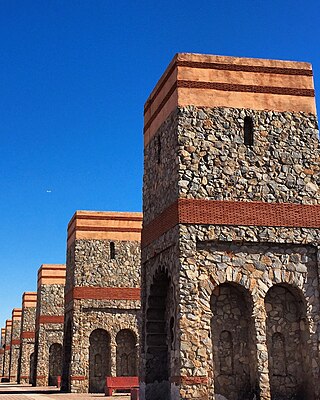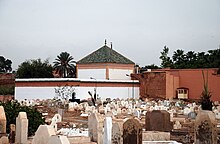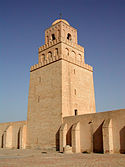Abu Muhammad Abd al-Malik ibn Hisham ibn Ayyub al-Himyari, known simply as Ibn Hisham, was a 9th-century Muslim historian and scholar. He grew up in Basra, in modern-day Iraq and later moved to Egypt.
Ṣāʿid al-Andalusī, in full Abū al-Qāsim Ṣāʿid ibn Abū al-Walīd Aḥmad ibn Abd al-Raḥmān ibn Muḥammad ibn Ṣāʿid ibn ʿUthmān al-Taghlibi al-Qūrtūbi, was an Arab qadi of Toledo in al-Andalus, who wrote on the history of science, philosophy and thought. He was a mathematician and scientist with a special interest in astronomy and compiled a famous biographic encyclopedia of science that quickly became popular in the empire and the Islamic East.
Ibn al-Abbār, he was Hāfiẓ Abū Abd Allāh Muḥammad ibn 'Abdullah ibn Abū Bakr al-Qudā'ī al-Balansī (1199–1260) a secretary to Hafsid dynasty princes, well-known poet, diplomat, jurist and hadith scholar from al-Andalus and perhaps the most famous man of letters produced by the city of Valencia ('Balansiya') during the Middle Ages.
Malik ibn al-Murahhal or Abu l-Hakam/Abu l-Mayd Malik ibn Abd al-Rahman ibn Ali ibn Abd al-Rahman ibn (al-)Faray ibn (al-)Azraq ibb Saad/Munir ibn Salim ibn (al-)Faray al-Masmudi al-Malaqi al-Sabti is considered to be one of the greatest Moroccan poets. He belonged to a Masmudi family and was born in Malaga, but grew up in Ceuta and was the chancellor of Marinid sultans like Abu Yusuf Yaqub. He is the author of 24 books among which a panegyric of the Prophet in popular form.

Yūsuf ibn ʿAbd Allāh ibn Muḥammad ibn ʿAbd al-Barr, Abū ʿUmar al-Namarī al-Andalusī al-Qurṭubī al-Mālikī, commonly known as Ibn ʿAbd al-Barr was an eleventh-century Maliki scholar and Athari theologian who served as the Qadi of Lisbon. He died in December 2, 1071 (aged 93).
Al-Udri or Al-Udhri, was an Arab Geographer, traveler and historian of al-Andalus. He hailed from the Arab tribe of Udra which had settled Almería.
Abu Abd Allah Muhammad ibn Muhammad al-Ifrani al-Susi al-Marrakushi, called al-Saghir, was a Moroccan historian and biographer.
Al-Tamimi, in full Abu Abd Allah Mohammed ibn Qasim ibn Abd ar-Rahman ibn al-Karim al-Tamimi al-Fasi was a Moroccan Arab hadith scholar and biographer, author of Al-Mustafad fi manaqib al-ubbad bi-madinat Fas wa ma yaliha min al-bilad. Al-Tamimi hailed from the Banu Tamim tribe which settled in al-Maghreb and al-Andalus.

Pierre Lory is a director of studies at the École pratique des hautes études, holder of the Chair of Muslim mysticism of the Ve section, religious sciences.

Marhab bin Al-Harith was popularly known as the Knight of Khaybar, a Jewish knight who is noted for his military role in Battle of Khaybar.
Abū Bakr az-Zubaydī, also known as Muḥammad ibn al-Ḥasan ibn ‘Abd Allāh ibn Madḥīj al-Faqīh and Muḥammad ibn al-Ḥasan az-Zubaydī al-Ishbīlī, held the title Akhbār al-fuquhā and wrote books on topics including philology, biography, history, philosophy, law, lexicology, and hadith.
Abu Musa al-Jazuli, was a Moroccan philologist and grammarian, who produced an encyclopaedia called Al-Qānūn, or Al-Muqaddima of al-Jazūlī. Many scholars wrote tafsir or sharḥ (commentaries), and it was incorporated in many grammars. Nevertheless, its opacity challenged the best language scholars. Al-Jazūlī was the first to introduce Al-Ṣiḥāḥ fī al-lughah of al-Jawhari to the Maghreb, and he makes many references to this and other works in his Muqaddima.

The Seven Saints of Marrakesh or Patron Saints of Marrakesh are seven historical Muslim figures buried in Marrakesh, Morocco. Each of them was a famous Muslim jurisprudent, scholar or wali venerated for their piety or other mystical attributes. Their tombs form the basis of a centuries-old annual pilgrimage or ziyara, during which visitors pray at each of their tombs over seven days.

The cession of Larache effectively took place on 20 November 1610, when Juan de Mendoza y Velasco, Marquis of San Germán, assumed control over the North African port of Larache on behalf of the Hispanic Monarchy.
Abū Bakr ibn al-Ḥasan ibn ʿAlī was the son of Hasan ibn Ali. He went to Karbala with his uncle Husayn ibn Ali, and was killed in the Battle of Karbala on the day of Ashura.
Abū Muḥammad ʿAbd Allāh ibn Muḥammad ibn Aḥmad al-Tijānī was a chancery official and author in the Hafsid Caliphate. He is best known for his Riḥla, an account of his travels in 1306–1309 and a detailed description of the land between Tunis and Tripoli.

Abū al-Ḥasan Bakrī is the purported author of several Islamic works in Arabic, most notably a biography of Muḥammad entitled Kitāb al-anwār. There is no consensus regarding his historicity or his floruit.







